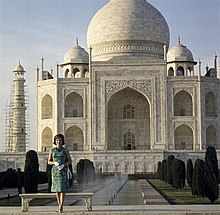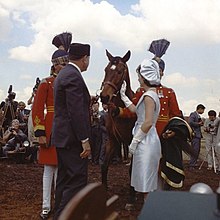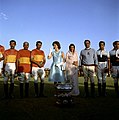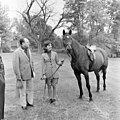
Jawaharlal Nehru was an Indian anti-colonial nationalist, statesman, secular humanist, social democrat, and author who was a central figure in India during the middle of the 20th century. Nehru was a principal leader of the Indian nationalist movement in the 1930s and 1940s. Upon India's independence in 1947, he served as the country's first prime minister for 16 years. Nehru promoted parliamentary democracy, secularism, and science and technology during the 1950s, powerfully influencing India's arc as a modern nation. In international affairs, he steered India clear of the two blocs of the Cold War. A well-regarded author, his books written in prison, such as Letters from a Father to His Daughter (1929), An Autobiography (1936) and The Discovery of India (1946), have been read around the world. The honorific Pandit has been commonly applied before his name.

Jacqueline "Jackie" Lee Kennedy Onassis was an American writer, book editor, and socialite who served as the first lady of the United States from 1961 to 1963, as the wife of President John F. Kennedy. A popular first lady, she endeared the American public with her devotion to her family, dedication to the historic preservation of the White House, the campaigns she led to preserve and restore historic landmarks and architecture along with her interest in American history, culture and arts. During her lifetime, she was regarded as an international icon for her unique fashion choices, and her work as a cultural ambassador of the United States made her very popular globally.

Feroze Gandhi was an Indian freedom fighter, politician and journalist.
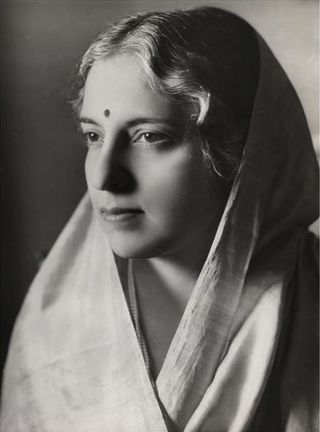
Vijaya Lakshmi Pandit was an Indian freedom fighter, diplomat and politician. She served as the 8th President of the United Nations General Assembly from 1953 to 1954, the first woman appointed to either post. She was also the 3rd Governor of Maharashtra from 1962 to 1964. Noted for her participation in the Indian independence movement, she was jailed several times during the movement.

Braj Kumar Nehru MBE, ICS was an Indian diplomat and Ambassador of India to the United States (1961–1968).

Kamala Nehru was an Indian independence activist and the wife of Jawaharlal Nehru, the first prime minister of India. Their daughter Indira Gandhi was the first female prime minister of India.
Providencia F. Paredes was the personal assistant to the First Lady of the United States Jacqueline Kennedy Onassis.

Lasata is an estate in East Hampton, New York, that was the childhood summer home of the future First Lady of the United States Jacqueline Kennedy Onassis until she was about 12.

The Nehru–Gandhi family is an Indian political family that has occupied a prominent place in the politics of India. The involvement of the family has traditionally revolved around the Indian National Congress, as various members have traditionally led the party. Three members of the family—Jawaharlal Nehru, Indira Gandhi and Rajiv Gandhi—have served as the prime minister of India, while several others have been members of parliament (MP).
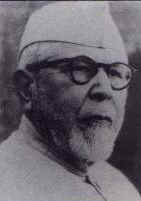
Abdul Majeed Khwaja was an Indian lawyer, educationist, social reformer and freedom fighter from Aligarh. In 1920, he along with others founded Jamia Millia Islamia and later served its vice chancellor and chancellor.

Jacqueline Bouvier Kennedy was wearing a pink Chanel suit when her husband, President John F. Kennedy, was assassinated in Dallas, Texas on November 22, 1963. She insisted on wearing the suit, stained with his blood, during the swearing-in of Lyndon B. Johnson that afternoon and for the flight back to Washington D.C. Jacqueline Kennedy was a fashion icon, and the suit is arguably the most referenced and revisited among her clothing items.
Marion Fay "Mimi" Alford is an American woman who allegedly had an affair with President John F. Kennedy while she served as an intern in the White House press office between 1962 and 1963.
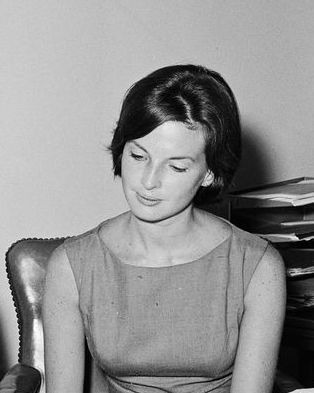
Pamela Harrison Turnure Timmins was the first Press Secretary hired to serve a First Lady of the United States. She was the Press Secretary to Jacqueline Kennedy. Turnure reportedly had an extramarital affair with 35th President of the United States John F. Kennedy.
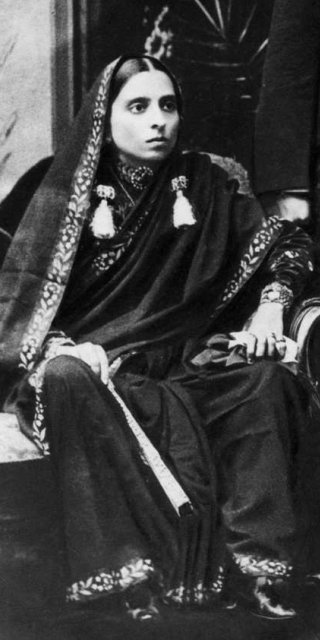
Swarup Rani Nehru was an Indian independence activist. She was the wife of barrister and Indian National Congress leader Motilal Nehru and the mother of India's first Prime Minister, Jawaharlal Nehru.
Jacqueline Kennedy: The White House Years was a 2001 exhibition that was presented by the Costume Institute at the Metropolitan Museum of Art. The event was timed to mark the 40th anniversary of her "emergence as America’s first lady." Organized by The Metropolitan Museum of Art and the John F. Kennedy Library and Museum, the exhibition was devoted to exploring the former First Lady's iconic style and impact on the fashion world.
Wexford, also known as Kennedy Retreat at Rattlesnake Ridge, is a 167-acre (0.67 km2) ranch amid the Blue Ridge Mountains in unincorporated Marshall, Virginia, located 4 miles (6 km) northwest from Middleburg. The property was acquired, designed, and named by Jacqueline Kennedy in 1962 as a weekend retreat during John F. Kennedy's presidency. Its namesake is the ancestral home of the Kennedy family. Following their visit to Wexford (Ireland) in June 1963, Éamon de Valera gifted 3-year old John F. Kennedy Jr. a pony, which was stabled at Wexford (ranch). It is the only home John and Jacqueline built together during their marriage, and was the last place they vacationed before his assassination in November 1963. John Jr. practiced his father's iconic final salute at Wexford.
Mary Van Rensselaer Thayer was an American socialite, journalist, and author. In 1929 she visited the Soviet Union and explored the Caucasus. She returned the following year. In 1931 she married Sigourney Thayer. Throughout that decade she wrote a column for the New York Journal and was a reporter in Eastern Europe in the aftermath of World War II. Thayer spent the 1950s to 1970s working for Magnum Photos and continuing to write news articles. She published two books on her close friend Jacqueline Kennedy.

Shobha Nehru, commonly known as Fori Nehru and Auntie Fori, was a Hungarian-born Indian social worker and the wife of the Indian civil servant Braj Kumar Nehru of the Nehru family.

A sari-inspired dress incorporates attributes of the Indian sari into its design. This includes how it drapes, its embellishment and colours.
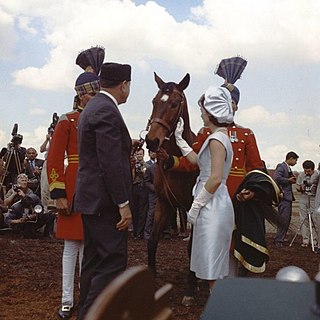
Sardar, was a Pakistani horse gifted to Jackie Kennedy in 1962 by Muhammad Ayub Khan, the then president of Pakistan, during her goodwill tour. In her memoirs, she called Sardar her "favorite treasure".
